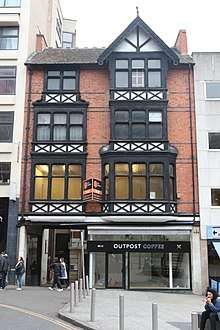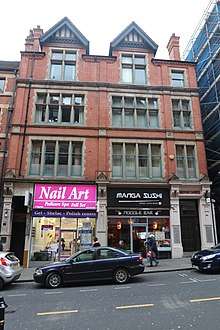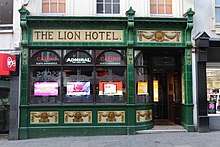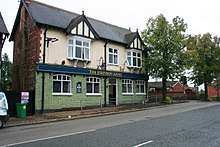Frederick Ball
Frederick Ball LRIBA (1861 – 26 July 1915) was an architect based in Nottingham.[1] He was Sheriff of Nottingham from 1906–07, and Mayor of Nottingham from 1913–1914.




History
He was born in 1861 in Lenton, the third son of George Ball (1823–1887) and Lois Attenborough (1826–1913).[2] His brother, Sir Albert Ball was Lord Mayor of Nottingham.
He studied under Richard Charles Sutton and became his assistant until 1880 when he established himself in independent practice in Nottingham.
Later he worked in partnership with John Lamb (1859–1949), trading as Ball & Lamb at 5 Houndsgate, until John Lamb established himself in private practice around 1907.
He was appointed Licentiate of the Royal Institute of British Architects in 1911.
He was elected to Nottingham City Council in 1902 as representative for Castle Ward.
In 1914 his residency was Clumber House, Lenton Avenue, The Park, Nottingham. According to his probate record of 14 December 1914, he died at the Clifton Hotel in Blackpool, Lancashire. He left an estate valued at £31,171 16s 9d (equivalent to £2,516,300 in 2019).[3]
Works
- School in West Bridgford
- School in Shirebrook
- Meadow Lane Infant School, Meadow Lane, Chilwell 1895
- 10 King Street, Nottingham 1894-96 (with John Lamb)
- Houses on Lenton Boulevard, junction with Willoughby Avenue 1896-97[4] (with John Lamb)
- House on Lenton Boulevard, junction with Derby Road 1896-97[4] (with John Lamb)
- Grosvenor Buildings, King Street, Nottingham 1896 (with John Lamb)
- Nottingham Co-operative Store, Church Street / Lenton Boulevard, Nottingham 1899[4]
- Alton’s Cigar Factory, Canning Circus, Nottingham 1900 (with John Lamb)
- Shops (now Hallam's Greengrocer) 21-23 High Road, Beeston, Nottingham 1903-04
- Houses 170-172 Station Road, Beeston 1904[5]
- Houses 186-194 Station Road, Beeston 1904[6]
- Houses 196-198 Station Road, Beeston 1905[7]
- Generous Briton public house, Alfreton Road, Nottingham
- White Lion Hotel, Clumber Street, Nottingham 1910[4]
- Nottingham and Nottinghamshire Bank, 513 Mansfield Road, Nottingham 1911
- Union Street Gospel Mission, Beeston, Nottingham 1912
- White Horse public house, Ilkeston Road, Nottingham 1912
- Johnson Arms public house, Lenton 1912
- Picture Palace, High Road, Beeston 1912-13 (rebuilt 1935, and demolished after closure in 1960)[8]
- Castle Ward Conservative Club, Church Street, Lenton 1912-13[4] new frontage. Now demolished
- Globe Picture Theatre, Trent Bridge, Nottingham 1913[9] (demolished 1969)
- Orion Picture Theatre, Alfreton Road, Nottingham 1913 (closed 1959 and later demolished)
- Parish rooms for All Souls’ Church, Radford 1914 (now Clement Pianos).
- Star Inn, Middle Street, Beeston, Nottingham 1915 (rebuilding)
References
- Brodie, Antonia (20 December 2001). Directory of British Architects 1834-1914: Vol 1 (A-K). Royal Institute of British Architects. p. 100. ISBN 0826455131.
- "Death of Alderman F. Ball". Nottingham Evening Post. England. 27 July 1915. Retrieved 14 January 2018 – via British Newspaper Archive.
- UK Retail Price Index inflation figures are based on data from Clark, Gregory (2017). "The Annual RPI and Average Earnings for Britain, 1209 to Present (New Series)". MeasuringWorth. Retrieved 2 February 2020.
- Harwood, Elain (2008). Pevsner Architectural Guides. Nottingham. Yale University Press. ISBN 9780300126662.
- "1290" (1878-1937) [Building Plan Register]. District Council Records, File: DC/BS/4/2/1. Nottingham: Nottinghamshire Archives Office.
- "1285" (1878-1937) [Building Plan Register]. District Council Records, File: DC/BS/4/2/1. Nottingham: Nottinghamshire Archives Office.
- "1286" (1878-1937) [Building Plan Register]. District Council Records, File: DC/BS/4/2/1. Nottingham: Nottinghamshire Archives Office.
- "Palace Cinema High Road and Station Road, Beeston, NG9 2JQ". Cinema Treasures. Retrieved 3 August 2019.
- "News". The Building News and Engineering Journal. 104: 336. 1913.
| Wikimedia Commons has media related to Frederick Ball. |